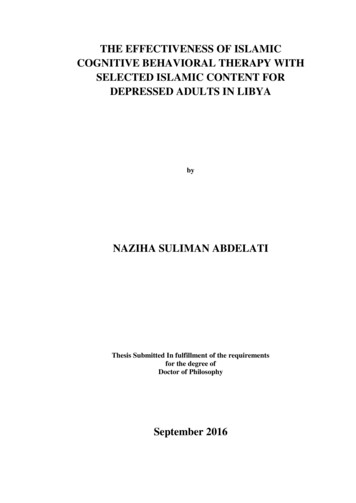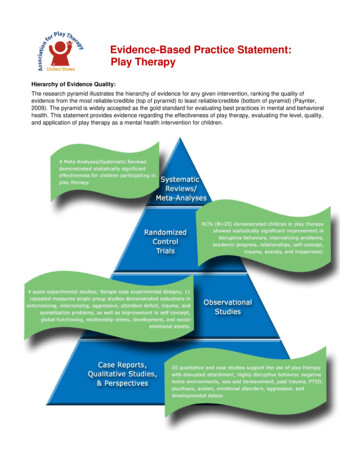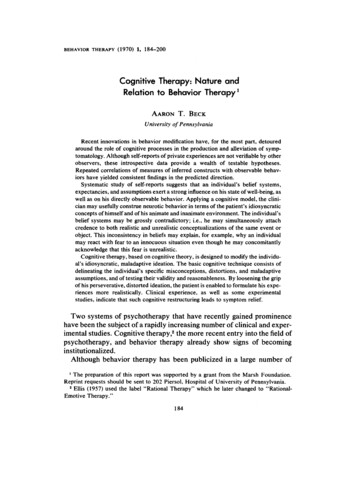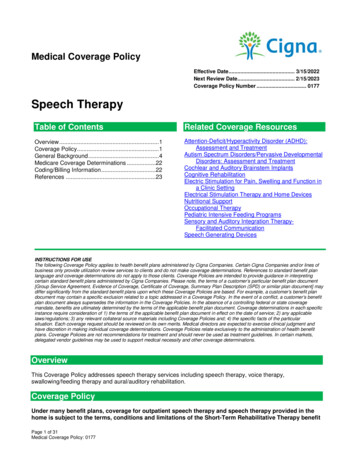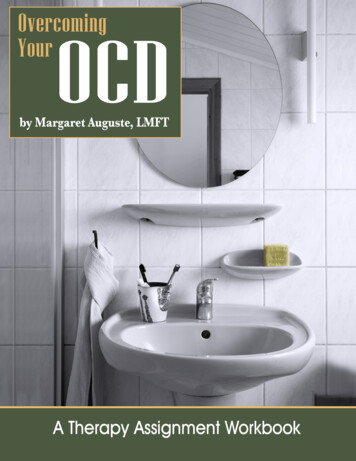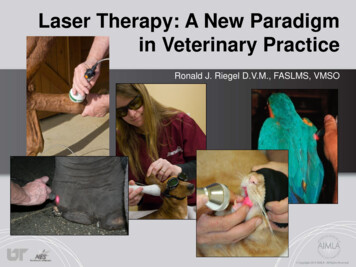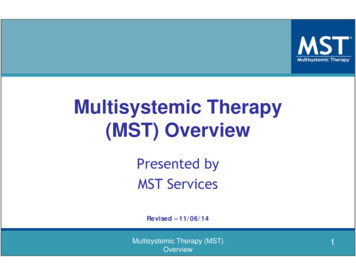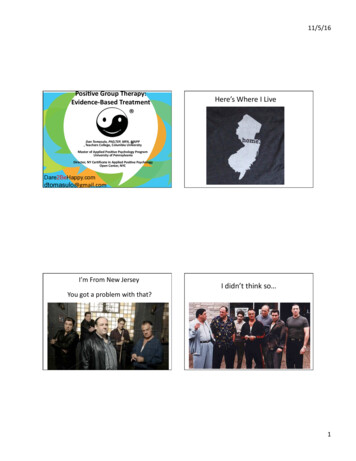
Transcription
11/5/16Posi%ve Group Therapy:Evidence-Based TreatmentHere’s Where I Live Dan Tomasulo, PhD,TEP, MFA, MAPP, Teachers College, Columbia University Master of Applied Posi%ve Psychology ProgramUniversity of PennsylvaniaDirector, NY Cer%ficate in Applied Posi%ve PsychologyOpen Center, NYCDare2BeHappy.comdtomasulo@gmail.comI’m From New JerseyYou got a problem with that?I didn’t think so 1
11/5/16 We have a choice about what wefeel We can change how we thinkand feel We can cultivate sustainablepositive feelings We can create and inspire this inothers /Wrong To StrongAmerican PsychologicalAssociation’s first bookon people withintellectual disabilities.IBT is the most widelyused evidenced-basedgroup model for peoplewith intellectual andpsychiatric disabilitiesDM-IDChapter on PosQraumaRc Stress DisorderTurning Anxiety ofTransforma%on intoTransforma%on of Anxiety2
11/5/16Posi&ve GroupPsychotherapyModified ForAdults WithIntellectualDisabili&esTomasulo, D. (2014). PosiRve GroupPsychotherapy for Adults with DualDiagnosis: A Proposed Model, Journal ofIntellectual Disabili&esNew Jersey PsychologistPublicaRon of the New Jersey Psychological AssociaRon Fall 2015 Volume 65 Number 3The ACTing cure:evidence-basedgroup treatmentfor people withintellectualdisabilitiesTomasulo, D., Szucs, A (2016) TheACTing Cure:Evidence-based group treatment forpeople withintellectual disabilities. Dramatherapy.American Snake PitPosi%vePsychologyForthcoming by SRllhouse Press3
11/5/16Teaching Vs. FacilitaRonSocial Skill Training ModelReliability Ratings onTherapeutic FactorsIBT RESEARCH More than a dozen studies have validatedprocess & outcome using the IBT. Here arethree studies focused on:1. InteracRon2. TherapeuRc Factors3. Global Assessment of FuncRoningIBT Model(Part of a Study by Ellen Keller, sality.90Altruism.76Installation of hope.86Guidance1.00Vicarious Learning/Modeling.45Catharsis.96Imparting of information.914
11/5/16An IBT Outcome Study Linda Daniels, PSY.D.(J. of Psychotherapy Practice &Research 1998; 7:167-176) IBT TreatmentVs Waiting List(20 subjects each) 16 sessions(50 minutes each)Global Assessment ofFunctioningTREATMENTMean43.8850.83SD(pre) 10.9(post) 11.6WAIT LISTMean43.9445.13SD(pre) 8.58(post) 9.36IBTInterac%ve –Behavioral TherapyAc%on Process In Group Work: 4 StageModifica%on Orienta%onWarm-up and SharingEnactmentAffirma%on5
11/5/16Overview of PosiRve Psychology,PERMA & PosiRve PsychologyTHE DOUBLE HAS THREEPURPOSES:1. Providing emotional support2. Giving emotional expression3. Reorganize perceptions. TherapeuRc Factors and Character StrengthsReadiness For ParRcipaRon & PrimingWarm up and Sharing and EngagementEnactment and RelaRonshipAffirmaRon and AcRve-ConstrucRveResponding, Meaning, and Achievement /AccomplishmentTherapeutic Factors & Character Strengths1.acceptance m12.self-understanding4.installaRon of hope13.socializing techniques5.guidance,14.existential factors6.modeling7.catharsis,8.imparRng of informaRon9.correcRve recapitulaRon ofthe primary family10. interpersonal learningIBT --The Psychology of PossibilityTherapeuRc Factors --14 StatesCharacter Strengths –24 Traits38 PossibiliRes for ChangeChanging the anxiety of transformaRoninto the transformaRon of anxiety6
11/5/16Learned HelplessnesstoLearned OpRmism Jonas Salk and MarRn Seligmanthe shik to Psychological ImmunizaRonPERMAFlourishing & Well-BeingWhat does it mean to flourish?PERMA Positive Experiences (Pleasure) Engagement Relationship Meaning Achievement20 tests on AuthenRcHappiness.org related toPERMA7
11/5/16Positive Experiences(Pleasure)Positivity Barbara Fredrickson andthe Positivity Ratio Negative thoughts arethree time stronger thanpositive thoughts The “Tipping Point” forthinking positively occurswhen we reach a criticalmass of 3 to 1 ratio ofpositive to negativethoughts. PositivityRatio.com“modest level of nega%ve affect, ifcombined with high levels of posi%veaffect, may help to generate crea%vity,”10 forms of mentInspiraRonAweLoveBroaden and Build --Tipping Point698
11/5/16Pebbles & FeathersThe EmoRonalPiggy BankPositive tThe Research On Flow and TheConnection To Well-being andSignature Strengths9
11/5/16MihalyCsikszentmihalyi In 1976 a book waswritten that arguablycreated the field ofpositive psychology’sfirst book Flow: The Psychologyof Optimal ExperienceCsikszentmihalyi said that flow is.The event is freely chosen; The goal is clear;There is a high degree of focus;A loss of self-consciousness occurs byengaging in the acRon; Time is distorted;Feedback on performance is immediate andconcrete; There is a sense of control in thesituaRon or acRvity; The challenge is high,but there is balance between ability and thetask; Bodily needs are less noRced; There iseffortlessness in the acRvity because it isintrinsically rewarding.Signature Strengths & FlowFight—Flight—Freeze—or— Flow.Using your signature strengths increase posiRveexperiences.“being completely involved in an activity for its ownsake. The ego falls away. Time flies. Every action,movement, and thought follows inevitably from theprevious one, like playing jazz. Your whole being isinvolved, and you’re using your skills to the utmost.”Those who use their top strengths regularlyreport being in flow more oken.10
11/5/16ACR ExamplesPositive tWhat Are You Going To do When Things Go eenshot%202016-03-27%2019.25.10.png?dl 0Full engagement& recogniRonCausing doubtUsurpgood newsMarginalacknowledgementPositive t11
11/5/16POSTTRAUMATICGROWTHWar DogThe art of resilienceWrong to Strong12
11/5/16 PosDrauma&c stress disorder is nowdevelopmentally sensi&ve in thatdiagnos&c thresholds have beenlowered for children and adolescents.PosiRve - IBT Based on PosiRve PsychotherapyGroup and Individual FormatUses Evidence-Based PosiRve IntervenRonsModified For Use For People With Low Literacy There is considerable evidence,however, of increased likelihood ofdisorganized or agitated behavior inindividuals with greater levels ofimpairmentLundrigan designed a questionnairebased upon Seligman’s ConsumerReports survey of client satisfactionwith mental health services(Seligman, 1995).Lundrigan, M. (2007). InteracRve Behavioral Therapy with intellectually disabled persons with psychiatricdisorders: A pragmaRc case study. Unpublished doctoral dissertaRon: Graduate School of Applied andProfessional Psychology, Rutgers University, New Brunswick, NJ.13
11/5/1640 IBT participants, all of whomwere dually diagnosed with IQsbetween 50 -70.Of the 40 clients who were surveyed,34 (85%) felt that they had beenhelped by participation in IBT.Does IBT work to reduce thesymptoms of depression anddoes it increase well-being?It is of note that this figurecorresponds closely to the 87%satisfaction rate found in theConsumer Reports studyThe most commonly sought-afterreason for treatment was depression 85% felt IBT helped them alleviatelow moods. 90 % felt IBT improved theirability to get along with others 82.5 % believed the therapyhelped them become moreproductive at work 80% felt it was helpful in copingwith everyday stress. 85% felt IBT helped them enjoy lifemore. 92.5% thought that therapy wasresponsible for personal growth andinsight. 95% noted their confidence andself-esteem had been bettered.14
11/5/16 97 % ranked their therapistcompetence as fair toexcellent. 100 % of the participants weresatisfied to completelysatisfied with their therapist Of the 40 participants nonereported that the therapy madethem worse.Resource Priming & Resource AcRvaRon Improved therapy outcomes Higher use of strengthsin the session, A stronger pracRRoner-clientrelaRonship More experiences of accomplishment(sense of mastery) Fluckiger, C., & Grosse Holtorth, M. (2008). Focusing the therapist’s aQenRon on thepaRent’s strengths: A preliminary study to foster a mechanism of change in outpaRentpsychotherapy. Journal of Clinical Psychology, 64, 876-890. Flukiger, C., Caspar, F., Grosse Holtorth, M., & Willutzki, U. (2009). Working with paRents’strengths: A microprocess approach. Psychotherapy Research, 19(2), 213-223. Fluckiger, C., & Wusten, G., Zinbarg, R. E., & Wampold, B. E. (2010). Resource ac&va&on:Using client’s own strengths in psychotherapy and counseling. Cambridge, MA: Hogrefe.15
11/5/16Psychodrama—The EncounterIBT6-MONTH CERTIFICATE PROGRAMDecember 2016–April 201716
Master of Applied Posi%ve Psychology Program University of Pennsylvania Director, NY Cer%ficate in Applied Posi%ve Psychology . PsyD.) 1. Acceptance/cohesion .86 2. Universality .90 3. Altruism .76 . Professional Psychology, Rutgers University, New Brunswick, NJ. 11/5/16 14
